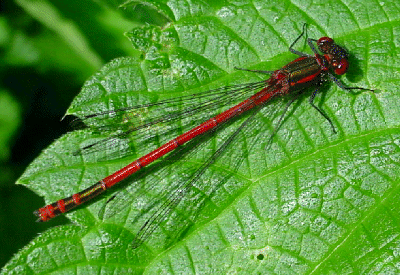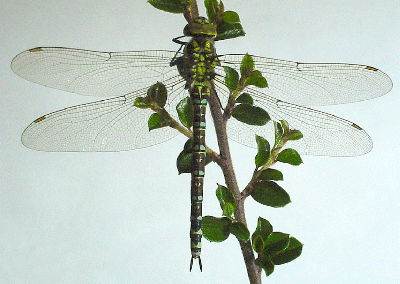
Consulting Entomologist

Tel/Fax: 01275 854224
E-Mail: [email protected]
Site Guide
Site Search
Home Page
Career Page
Insect Files
- Contents
- Bug Index
- The World of Bugs
- Classification of Bugs
- Insect Identification
- Insect Fossils
- Insect Body-parts
- Micro View of Bugs
- Insect Life Cycles
- Insect Defences
- Insects of Nailsea
- Pesticide Safety
- Bibliography
Shortcut to the main groups of insects and other arthropods...
Bug Rhymes & Poems
Links
Shop
Payments (credit/debit card)
Order Odonata - Dragonflies and Damselflies(Odonata, from Greek odontos = tooth) |
Class: Insecta Order: Odonata | |
| Examples: | ||
|
Large winged insects, with very elongate bodies; usually brightly coloured. Eyes very large and prominent. Antennae small and filamentous. Mouthparts for biting, with mandibles strongly toothed (from which the order gets its name). Two pairs of narrow, shiny, membranous wings, with an intricate network of veins. Damselflies hold the wings vertically over the body or partly spread when at rest, whereas the dragonflies always rest with wings outspread. Abdomen with a pair of small, 1-segmented cerci. Simple metamorphosis, with 10-15 nymphal instars depending on species. The nymphs are aquatic and breath by means of internal rectal gills (dragonflies) or by means of three external abdominal 'tails', which form feather-like caudal gills (damselflies). The mouthparts of nymphs are cleverly modified to form an elongate, prehensile structure known as the mask (see below). This structure is hinged in the middle and bears a pair of terminal claws. The whole arrangement is called the mask because when not in use and folded back under the head, it conceals the rest of the mouthparts. When food is sighted, the mask is thrown forward and the prey is impaled on the claws. Over 4,500 species are described and just over 40 of these are recorded from the British Isles. |
|
|
|
|
|
Head of a dragonfly nymph showing the mask partly extended Illustration: adapted from Weber 1933 |
Dragonfly nymph |
Damselfly nymph (with mask extended) Photos: V.J. Stanek © |
|
| |
| Large Red Damselfly - Pyrrhosoma nymphula | |
|
Description. About 30-35 mm long. Thorax with red stripes; abdomen red, with or without black markings (female usually with more black markings than the male). Biology. Found mainly near still water (small ponds, etc.), but often seen away from water, around hedgerows and gardens. One of the first damselflies to appear in spring. Feeds on other insects which it captures in mid-air with its legs. The aquatic nymphs are also predators, feeding on other small aquatic animals among the water weeds. They have a sort of territorial behaviour, defending a feeding locality and driving off intruding nymphs. Development may take one or two years. Distribution. Widespread throughout most of Britain. <<< TOP |
|
|
RELATED PAGES (Other Odonata) | |||
|
INSECTS OF NAILSEA |
GENERAL INSECT GALLERY |
||
|
(classification of insects) |
(identification key to insect orders) |
| <<< TOP | (use the back button on your web browser to return to the previous page) | TOP >>> |

